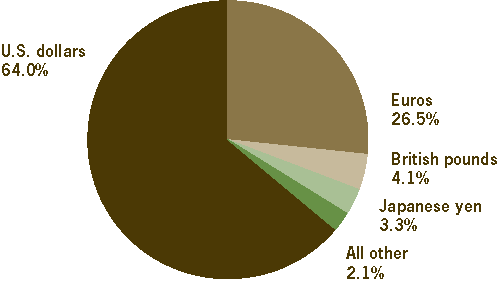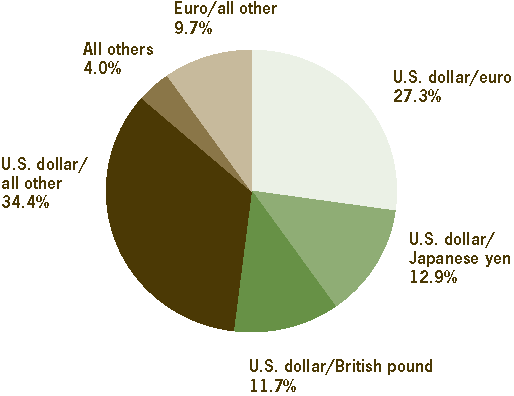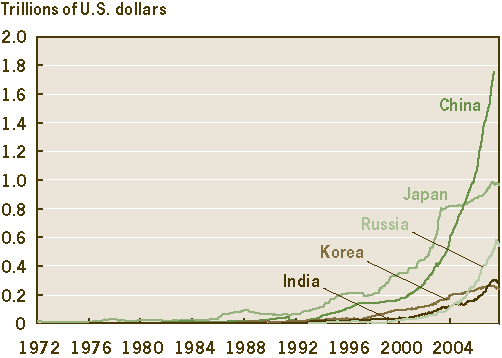- Share
Replacing the Dollar with Special Drawing Rights - Will It Work This Time?
The head of China’s central bank is calling for countries to replace the U.S. dollar as an international reserve currency with something called SDRs. Created by the IMF way back in 1969 for that purpose, SDRs never caught on. While SDRs may be declared an official international reserve asset today, they are not likely to become the world’s key international currency anytime soon. In the meantime, countries in China’s current predicament—acquiring more dollars than they think prudent—could avoid such risks in the future by allowing their currencies to appreciate.
The views authors express in Economic Commentary are theirs and not necessarily those of the Federal Reserve Bank of Cleveland or the Board of Governors of the Federal Reserve System. The series editor is Tasia Hane. This paper and its data are subject to revision; please visit clevelandfed.org for updates.
The head of China’s central bank is calling for countries to replace the U.S. dollar as an international reserve currency with something called SDRs. Created by the IMF way back in 1969 for that purpose, SDRs never caught on. While SDRs may be declared an official international reserve asset today, they are not likely to become the world’s key international currency anytime soon. In the meantime, countries in China’s current predicament—acquiring more dollars than they think prudent—could avoid such risks in the future by allowing their currencies to appreciate.
Zhou Xiaochuan, governor of the Bank of China, wants a new international reserve currency, one that is “disconnected from economic conditions and sovereign interests of any single country.” He claims that credit-based national reserve currencies, like the dollar, are inherently risky, facilitate global imbalances, and foster the spread of financial crises, but China’s concerns may also be a bit more parochial. The country holds a huge portfolio of dollar-denominated assets that could incur valuation losses, if recent U.S. actions to limit financial turmoil and stimulate the economy generate inflation and dollar depreciation.
The People’s Bank of China has offered a fix to the dollar problem. They recommend supplanting the reserve-currency role of the U.S. dollar with Special Drawing Rights (SDRs), a composite currency issued by the International Monetary Fund (IMF). Others, including Nobel Prize winner Joseph Stiglitz and a U.N. panel of experts, have endorsed the idea.
Adopting the SDR as an official international reserve asset may be technically feasible and it could conceivably occur fairly quickly, but substituting the SDR for the dollar more broadly as the world’s key international currency will not happen anytime soon. People reap substantial economies from conducting cross-border commerce in dollars, and until the SDR matches these benefits, central banks will still need dollars. In the interim, countries that want to limit their exposure to credit-based reserve currencies, like the dollar, might simply allow their currencies to appreciate.
Something Old, Something New
Complaints about the dollar and a fascination with SDRs are not new. The IMF created SDRs as an international reserve currency in the late 1960s to solve problems, similar to Dr. Zhou’s concerns, which rose out of the Bretton Woods fixed-exchange-rate system. Although Bretton Woods was at its heart a gold-based currency arrangement, the U.S. dollar quickly emerged as the key international currency, both for financing international commerce and as an official reserve currency.
Today, as during Bretton Woods, countries accumulate foreign exchange when they prevent or limit the appreciation of their currencies in the face of persistent trade surpluses and foreign financial inflows. Once acquired, official reserves then provide these countries with a buffer stock that they can draw down to mitigate the disruptive economic effects of unexpected trade shortfalls and temporary outflows of foreign funds. Absent such reserves, these countries would either have to allow their currencies to depreciate or quickly tighten their monetary policies, but such abrupt adjustments could be disruptive and might not be compatible with these countries’ current goals for inflation or real economic growth. At its heart, the desire to acquire and hold official foreign-exchange reserves reflects a desire to prevent, or at least limit, exchange-rate adjustments.
About 15 years into the Bretton Woods era—just like today—many countries began to view their holdings of official U.S. dollar reserves as excessive, and they worried that the United States might be forced to devalue the dollar. A dollar devaluation would saddle these countries with foreign exchange losses, since a devalued dollar would buy less abroad. As the situation unfolded, some countries, led by France, sought to replace the dollar with a reserve currency unrelated to a single national currency, if not solely related to gold.
The IMF—then the guardian of the Bretton Woods parity grid—came up with the SDR. The IMF initially defined the SDR in terms of a fixed amount of gold, then equal to one dollar, and allocated 9.3 billion SDRs between 1970 and 1972 to member countries in proportion to their quotas in the IMF. Before the SDRs even hit the shelf, however, President Nixon threw a wrench in the Bretton Woods works. He closed the U.S. gold window on August 15, 1971, refusing thereafter to convert dollar reserves into U.S. gold. Countries holding dollars were stuck. By March 1973, the large developed countries had all allowed their currencies to float against the dollar, ending their need to acquire dollar reserves.
With the advent of floating exchange rates, the IMF redefined the SDR as a weighted average of the U.S. dollar, the British pound, the Japanese yen, and the currencies that eventually comprised the euro. The dollar has the largest weight, currently about 40 percent, so changes in the dollar impact the SDRs more than similar changes in the pound, yen, or euro. Because of its construction, however, the SDR will likely be more stable relative to other currencies than the dollar; so, holding a portfolio of SDRs is liable to present a country with less exchange-rate valuation risk than holding dollars.
While many in the late 1960s and early 1970s believed that the SDR would supplant reserve currencies and possibly even gold in official portfolios, the SDR basically died at birth. The IMF made a second allocation of 21.4 billion SDRs between 1979 and 1981, again in proportion to member countries’ quotas, but the SDR quickly devolved for the most part into a unit of account, primarily on the IMF’s books, as the large developed countries accepted floating exchange rates as the norm.
If countries are willing to allow their exchange rates to adjust freely to trade flows and to cross-border movements of financial funds, they do not need official foreign-exchange assets. Despite the widespread acceptance of floating exchange rates, however, no country—including the United States—has completely tossed out their portfolio of foreign-exchange reserves. They keep some around just in case they may sometimes want to support their exchange rates. In doing so, they accept that the exchange value of these reserves will fluctuate from time to time.
The Dollar
The reserve currency of choice is the dollar (figure 1). The IMF estimates that 64 percent of the world’s official foreign-exchange reserves are held in dollar-denominated assets. The euro, the second most widely held international reserve currency, lags well behind, followed by the British pound and Japanese yen. These currencies’ rankings as official reserves parallel their status in international commerce more generally. This correlation should be of no surprise. Why hold a currency that no one uses?
Figure 1. The Currency Composition of Reserve Holdings

Source: International Monetary Fund, International Financial Statistics, COFER data.
Figure 2. Exchange Rate Pairs

Source: Bank for International Settlements, Triennial Central Bank Survey, 2007.
The dollar’s status as an official reserve currency reflects its broader role as the key international currency. According to a 2007 survey, roughly $3.2 trillion worth of foreign exchange trades hands each day, and 86 percent of those transactions involve dollars (figure 2). Again the euro is a distant second, with the British pound and Japanese yen trailing.
Many of the foreign-exchange transactions that are denominated and undertaken in dollars do not directly involve U.S. residents. A Japanese company looking to buy Brazilian coffee will face a dollar price and make payment in dollars. International trade in fairly standardized commodities, like oil, coffee, and grains, and in products that sell in highly competitive markets—including many financial instruments—is typically denominated in U.S. dollars. Invoicing in a single currency helps producers keep their prices in line with their competitors and simplifies price comparisons across the different producers. Naturally, the gains of a single currency rise with the number of producers, since it simplifies a wider range of price comparisons.
In contrast, international trade in heterogeneous manufactured goods, where pure price competition is not as crucial, tends to be denominated in the exporters’ currencies, but even in these cases importers—or their banks—will often acquire the exporters’ currencies by first trading their home currencies for U.S. dollars and then trading U.S. dollars for the exporters’ currencies. The world has found significant cost savings from these arrangements.
The dollar has maintained this role over the years, despite substantial fluctuations in its exchange value because the size, sophistication, and relative stability of the U.S. economy generally render the costs of transacting in U.S. dollars lower than the costs of transacting in other currencies that do not equally share these characteristics. In large part, the widespread use of the dollar developed and continued because the United States has been the largest, most broad-based exporter and importer in the world. With a lot of Americans trading globally, a lot of dollars will naturally change hands. As a consequence, traders must finance a large portion of their business in U.S. dollars, so they maintain accounts in dollars, seek loans in dollars, and undertake myriad other financial arrangements in dollars.
A strong and open U.S. financial system helped facilitate the dollar’s international use. Of course, a high degree of feedback naturally exists between the dollar’s expanding role in trade and the growth of an accommodating financial structure. Nevertheless, U.S. financial markets have always been innovative and relatively free of cumbersome regulations. They offer many different types of financial instruments and well-developed secondary markets, which enhances the liquidity of dollar-denominated assets. All this makes holding dollars convenient and transacting in dollars relatively easy. Moreover, as dollar trade expands, U.S. financial markets grow and more and more foreign financial firms—even ones not located in the United States—offer dollar-denominated products, further reducing the costs of transacting globally in dollars.
As more and more people use dollars in international commerce—as the global network for dollars expands—the benefits of using the dollar in exchange rise. The network benefits of an international currency are much like the network benefits of a language. As more and more people across the globe learn to speak English—as compared to, say, Welsh—then learning English, instead of Welsh, is increasingly valuable in terms of one’s ability to communicate. The process is self-reinforcing.
Moreover, once the network benefits of a particular international currency—or a language—become substantial, people are prone to continue using it, even if a viable competitor exists. Making the jump from the dollar to a new international currency, like the SDR or even the euro, requires everyone—or at least a substantial proportion of people—to make the jump in close concert. Otherwise, the network benefits are lost. For that reason, the world is not likely to shift quickly away from dollars even if the SDRs become a new international-reserve option.
Tipping Point
Of course, persistently bad U.S. economic policy could push people into a new international currency. If foreigners suspected that the costs of holding dollars in terms of lost purchasing power would soon exceed the network benefits of transacting in dollars, they would migrate to an alternative international currency. To generate such an expectation, the Federal Reserve System would need to run a substantially higher inflation rate than the rest of the world for a prolonged period of time.
At its core, China’s SDR plan may reflect such a concern. Since September 2008, the Federal Reserve System has undertaken a $1.2 trillion expansion of its balance sheet, unprecedented in terms of size and the types of assets that the System has acquired. Other key central banks have responded similarly. With the global economy currently in a deep recession, inflation is not a present concern, but at some point—later this year by most accounts—the U.S. economy will stabilize and begin to reverse course, and the Federal Reserve will need to do likewise. The System will be doing so in the face of substantial federal budget deficits, which are likely to exceed a whopping 6.4 percent of GDP by fiscal year 2011. To be sure, this unwinding will be challenging, but predictions of inflation and dollar depreciation currently seem more akin to guesswork than forecast. The Federal Reserve successfully weathered similar storms in the 1980s.
What’s a Country to Do?
In the meantime, countries—like China—that are worried about their expanding dollar portfolios have another option: allow their currencies to appreciate. Countries acquire foreign-exchange reserves when they limit the extent to which their currencies appreciate in the face of persistent trade surpluses and foreign financial inflows.
China is a classic example. Between mid-1995 and mid-2005, the People’s Bank of China maintained a fixed peg between its currency, the renminbi, and the U.S. dollar, by buying up the dollars rapidly flowing into China through trade and investments. China’s foreign-exchange reserves—65 percent to 70 percent of which are in dollar-denominated assets—grew sharply (figure 3). Had the People’s Bank not bought up the dollars at the existing pegged value, the strong inflow of dollars would have lowered the renminbi price of dollars—that is, the renminbi would have appreciated against the dollar. A renminbi appreciation would have reduced Chinese exports, encouraged Chinese imports, and slowed dollar inflows.
Figure 3. Foreign Exchange Reserves

Source: International Monetary Fund, International Financial Statistics.
Between mid-2005 and mid-2008, the People’s Bank allowed the renminbi to appreciate 19 percent against the dollar, but China’s reserves continued their skyward trajectory, suggesting that the People’s Bank still limited the renminbi’s appreciation. Since then, the renminbi has remained little changed relative to the dollar.
All this is fine—many countries see benefits in managing their exchange rates, particularly to avoid appreciations. Holding a foreign-exchange exposure, however, is simply the cost of doing so.
Recommended Readings
- “Reform the International Monetary System,” by Zhou Xiaochuan. March 3, 2009. People’s Bank of China.
- “China, the U.S. Dollar, and SDRs,” by Bennett T. McCallum. April 24, 2009. Presentation at the Shadow Open Market Committee, Cato Institute, Washington, D.C.
This work by Federal Reserve Bank of Cleveland is licensed under Creative Commons Attribution-NonCommercial 4.0 International





